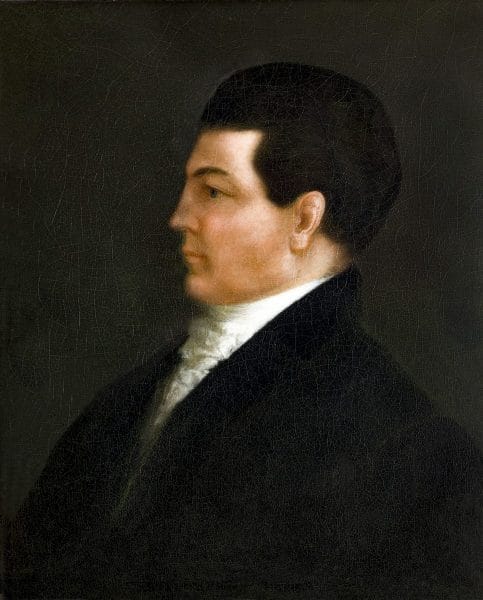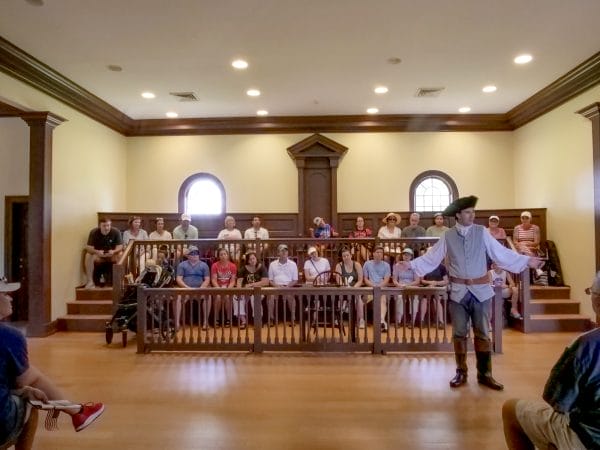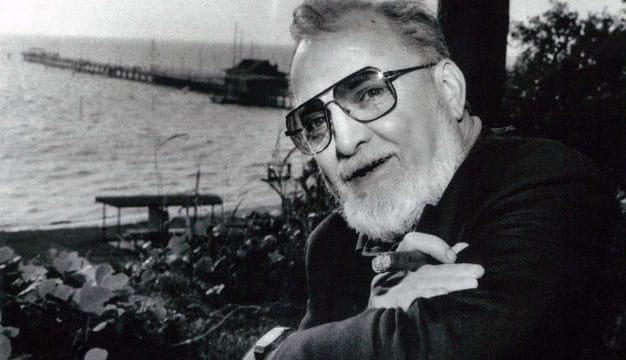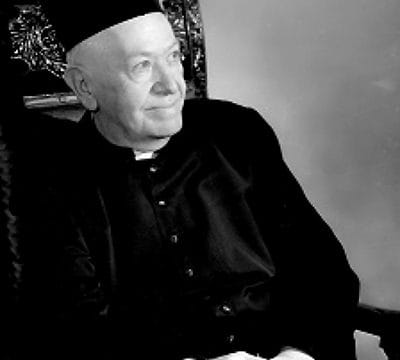Revolutionary War Veterans in Alabama
 Ephraim Kirby
Although Alabama became a state 36 years after the official conclusion of the American Revolutionary War in 1783, there is evidence that more than 1,000 Revolutionary War veterans lived in Alabama for at least a portion of their post-war lives. A small proportion of these veterans arrived as early as a decade prior to Alabama’s 1819 statehood. Many others came during the 1820s and 1830s, during the height of the land-rush known as “Alabama Fever.” In large measure, however, this migration concluded by the 1840s. The basic catalyst for this migration was the availability of low-cost land that had been taken from Native American tribes and distributed by the new United States government.
Ephraim Kirby
Although Alabama became a state 36 years after the official conclusion of the American Revolutionary War in 1783, there is evidence that more than 1,000 Revolutionary War veterans lived in Alabama for at least a portion of their post-war lives. A small proportion of these veterans arrived as early as a decade prior to Alabama’s 1819 statehood. Many others came during the 1820s and 1830s, during the height of the land-rush known as “Alabama Fever.” In large measure, however, this migration concluded by the 1840s. The basic catalyst for this migration was the availability of low-cost land that had been taken from Native American tribes and distributed by the new United States government.
More than 1,200 individuals with demonstrable involvement in the Revolutionary War were later associated with Alabama in one or more ways. Some applied for a Revolutionary War pension in Alabama, received a Revolutionary War pension in Alabama, or transferred a Revolutionary War pension to the state. Others were known to have resided in Alabama, died in Alabama, were buried in Alabama, or have a memorial marker in Alabama. The American Village historical park in Montevallo, Shelby County, is a 200-acre complex that features replica buildings representing sites that were important during the American Revolution and the nation’s founding. It is home to the National Veterans Shrine and Register of Honor, which documents veteran’s of U.S. wars, including the Revolution.
Information about these Alabamians who supported the cause for independence was gleaned from a variety of sources and used to construct the Revolutionary War Patriots in Alabama (RWPA) database. It lists approximately 1,200 individuals along with their type of service and unit, Alabama county of association, sources of information, date of birth and place, date of death and place, and cemetery location, if known. Among the sources were Thomas M. Owen‘s Revolutionary Soldiers in Alabama, which was first published in 1911 and updated in 1944, and Alabama’s American Revolutionary War Soldiers and Patriots, compiled by Walter Dockery, chairman of the Alabama Sons of the American Revolution (ALSSAR) Revolutionary War Graves committee, with the assistance of his wife, Gwendolyn. Other key sources were Southern Campaigns Revolutionary War Pension Statements, the Patriot Research System of the Sons of the American Revolution, and the Ancestor Database from the Genealogical Research System operated by the Daughters of the American Revolution.
 William Wyatt Bibb, 1819
Revolutionary War veterans, the nation’s first veterans, arrived in Alabama via two basic migration paths. One involved veterans primarily from Virginia, the Carolinas, and northern Georgia around the Broad River who emigrated largely to present-day Huntsville and surrounding areas in Madison County and a collection of other counties in the northeast corner of the state. These included future governors William Wyatt and Thomas Bibb, whose father was a captain in the Revolutionary Army and settled in Georgia after the war. A second migration entailed veterans who journeyed from Virginia and the Carolinas to Georgia and then to various pockets of central and western Alabama, such as Tuscaloosa. One such veteran was James McCrory, a native of Ireland who joined North Carolina’s 9th Regiment and later served as a member of George Washington’s “Life Guard.” After the war, McCrory settled in Pickens County just outside of Tuscaloosa. Not all of these veterans remained in Alabama for the duration of their lives. Some did, but others resided in Alabama for a while and then moved to other states, typically further west.
William Wyatt Bibb, 1819
Revolutionary War veterans, the nation’s first veterans, arrived in Alabama via two basic migration paths. One involved veterans primarily from Virginia, the Carolinas, and northern Georgia around the Broad River who emigrated largely to present-day Huntsville and surrounding areas in Madison County and a collection of other counties in the northeast corner of the state. These included future governors William Wyatt and Thomas Bibb, whose father was a captain in the Revolutionary Army and settled in Georgia after the war. A second migration entailed veterans who journeyed from Virginia and the Carolinas to Georgia and then to various pockets of central and western Alabama, such as Tuscaloosa. One such veteran was James McCrory, a native of Ireland who joined North Carolina’s 9th Regiment and later served as a member of George Washington’s “Life Guard.” After the war, McCrory settled in Pickens County just outside of Tuscaloosa. Not all of these veterans remained in Alabama for the duration of their lives. Some did, but others resided in Alabama for a while and then moved to other states, typically further west.
The Alabama-based veterans were, as expected, young and generally of low/enlisted ranks during the Revolutionary War. Very few were commissioned officers. A majority were less than 20 years of age at the time of the conflict. A large proportion had brief terms of service (three months) in a state-controlled militia unit, whereas a small number served in more than one state militia during the eight years of the conflict. Approximately one in five were enrolled in the new national government’s military units, known as Continental Regulars or the continental line. These “regulars” had longer tours of duty, typically one year or longer.
 Virginia House of Burgesses
Although there were probably more, two women were identified as Alabama-based veterans. Mary Witherspoon Conyers, a resident of Greene County, provided food and cooking services for the troops, and Elizabeth Duckett Casey of Lauderdale County provided supplies. Two “free men of color” listed as veterans were Frederick Gowen and Jim Capers of Lawrence County and Pike County, respectively. Because Capers’s wife was enslaved during the time of his death, she was unable to claim a widow’s pension in the 1850s. Alabama law at the time prohibited manumission by her owner. Veteran John Floyd, who claimed to have joined the fight at the age of 14 near its end, was an important military leader in Alabama during the Creek War of 1813-14. Private William Vance, who fought with a New Jersey regiment, is buried in Mobile‘s Church Street Graveyard.
Virginia House of Burgesses
Although there were probably more, two women were identified as Alabama-based veterans. Mary Witherspoon Conyers, a resident of Greene County, provided food and cooking services for the troops, and Elizabeth Duckett Casey of Lauderdale County provided supplies. Two “free men of color” listed as veterans were Frederick Gowen and Jim Capers of Lawrence County and Pike County, respectively. Because Capers’s wife was enslaved during the time of his death, she was unable to claim a widow’s pension in the 1850s. Alabama law at the time prohibited manumission by her owner. Veteran John Floyd, who claimed to have joined the fight at the age of 14 near its end, was an important military leader in Alabama during the Creek War of 1813-14. Private William Vance, who fought with a New Jersey regiment, is buried in Mobile‘s Church Street Graveyard.
More than 90 percent of these Alabama-based veterans were born in one of the 13 colonies prior to nationhood. Approximately 75 percent were natives of either Virginia, North Carolina, or South Carolina. Alabama-based veterans born in the mid-Atlantic or New England states comprise less than 10 percent of the group. Only eight percent were born outside of the colonies, mostly in England, Ireland, and Scotland.
Whereas 92 percent of Alabama-based veterans acquire the status or label of “Patriot” as a result of military service, others are labelled “Patriot” typically for providing supplies and service for the revolutionary cause or for taking a public oath of allegiance to the United States of America and renouncing allegiance to the English Crown. These various criteria for determination of “Patriot” status derive from extensive work by the National Society, Daughters of the American Revolution (DAR) and the National Society, Sons of the American Revolution (SAR), whose members are bloodline descendants of Revolutionary War veterans.
Information about these veterans with an Alabama connection can be found in the database entitled Revolutionary War Patriots in Alabama (RWPA), by searching either last name or county. This database was a large-scale undertaking of the Tennessee Valley Chapter of SAR during 2020 and 2021. The chapter collaborated with the Maple Hill Chapter of DAR and received technical support from the COLSA Corporation in Huntsville. The integration of information from several primary and secondary sources resulted in a list of 1,200-plus veterans who had at least one of seven associations with Alabama.
In some prior compilations of Alabama-based veterans, researchers occasionally relied upon folklore and questionable secondary sources. While containing valuable information, these efforts lacked advantages provided by today’s extensive digitization of records and greatly improved access to authoritative sources. The RWPA dataset includes a profile of each Alabama-based veteran, but also contains cautionary notes about the veteran status for 166 entries. Despite access to multiple authoritative sources by compilers of the RWPA, critical information about many of these veterans is unfortunately still missing, especially burial location. The RWPA database permits a quick search of Alabama-based veterans by county of affiliation or by last name.
Further Reading
- Owen, Thomas M. Revolutionary Soldiers of Alabama. Bulletin No. 5. Montgomery, Ala.: Brown Printing Company, 1911.



